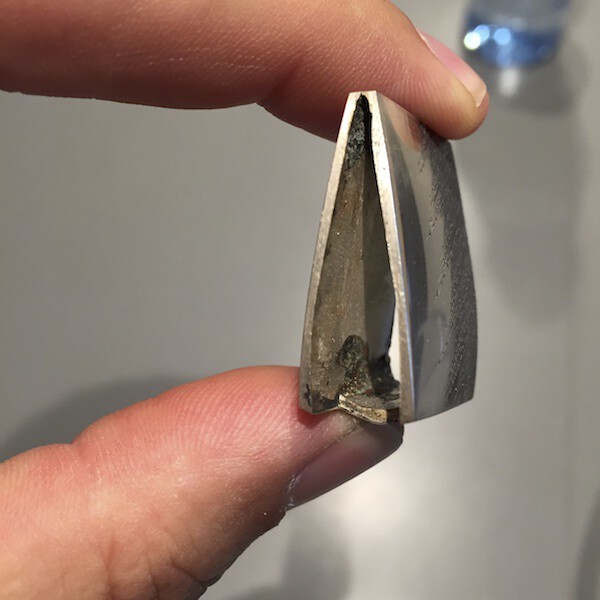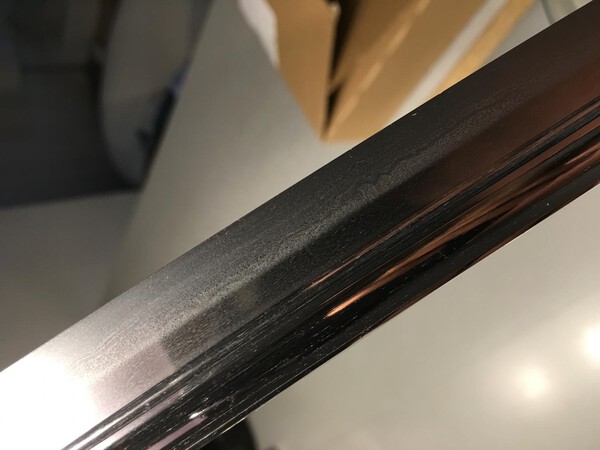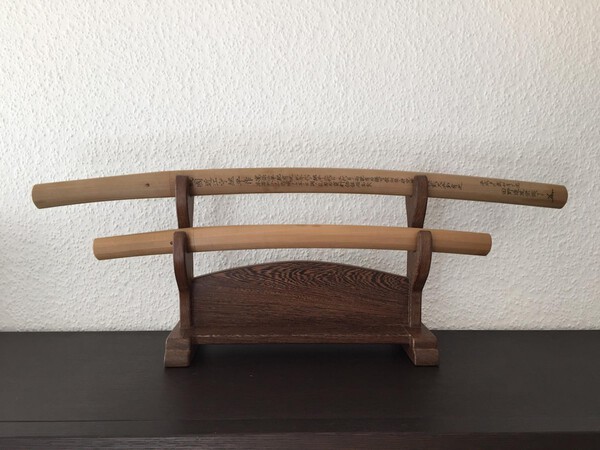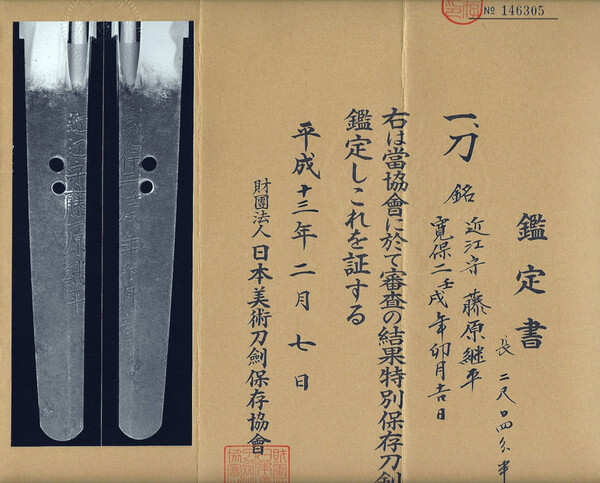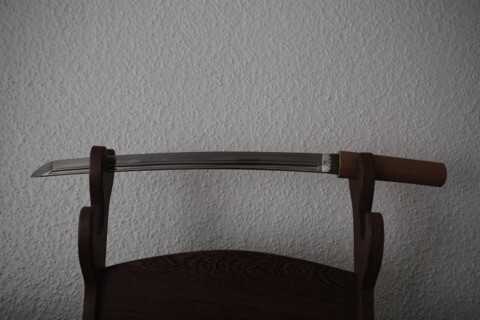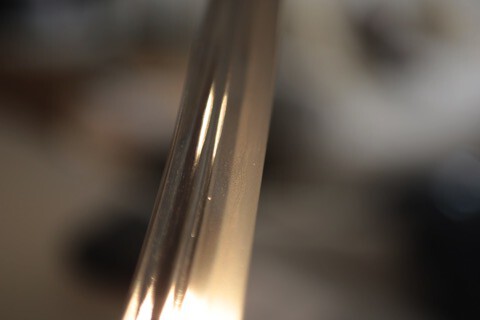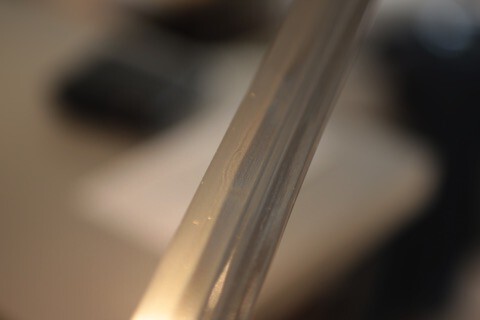-
Posts
179 -
Joined
-
Last visited
Content Type
Profiles
Forums
Events
Store
Downloads
Gallery
Everything posted by AndreasU
-
And another pretty example of a "mixed" Koshirae where the Tsuka has been cutted to stick on crappy Kogai .....Alone this would leave me miles away from this reseller....
-
Hi Judas, I can understand some of your thoughts but let me try to explain it that way. We are talking in this board about "historic antique swords" In the day these swords were made, their main purpose was to fulfill a task, protect the daimyos prpperty through the "employed" Samurai. Then the swords were handed over generation by generation, have been used more or less but have been preserved and polished a few times (most of them at least, easiliy recognisable as "flatter" the Ji got... latest then, the main purpose, beeing a weapon, was lost more and more as the sword got weaker and weaker. I am quite confident that most of the current swords available, yet high priced swords, are even weaker than a newly made modern one simply by the fact that they are old! But this doesn't matter for us as we mainly appreciate the skill and the craftmanship. Undoubtedly any "old" Japanese" sword will be more reliable then any old European sword you might find from the same age... if there is any in a healthy condition.... So your idea to "use" them is that far away from beeing realistic as can be. Your comparison with cars is not even close enough as most of the engines still used in US made production cars are simply old-fashioned technology based ones where improvements are just minor. Then it is better to have a look into the Japanese engine market where there is a lot more innovation if you want to compare this or of course into the german made engines To get a spare part for an old mid 50th 8cylinder US engine is a simple task where it is nearly impossible to find a complete authentic Saya with tsuba, menuki, and Kogai that was done for the specific sword in Edo or earlier. Simply because due to profit situation most of the Japanese resellers have disassembled these Sayas (mounting) to get most profit possible by seperately selling the Kogai and Tsuba. AOI art is a pretty example sometimes. Just some days ago he was "advertising" a stunning sword with matching Saya where it was obvious that the Tsuba was in best case to be described a washer...... Having said this, If you want to have a "real" Japanese sword that is as close as possible to the "old" Japanese swords (collectors items) have a look out for Gendaito made in the WWII using Tamahagane (no mass production ones) In my opinion, even a highly skilled swordsmith did them, they are no collectibles as they are done far after the last real Samurai's exist (pre 1868) and have in my eyes no "soul or spirit" left, simply said, they have NO HISTORY! This sounds drastically but is my way of appreciating these Swords. Even I like to look at a modern Gassan sword and truly he is a stunning Smith, they are "just" representing the tradition but will never have the same meaning any more than pre 1868 made ones. If I had the money to buy a sword in the price range of a modern made Gassan one or a antique made Yasutsugu, I would always go for the Yasutsugu or any other valuable Smith. This just as example. So to use a gendaito for any practice will bring you as close possible to what you are looking for but will net destroy any value or valuable Sword. Regarding the full set of "mountings" (I will leave it with this, for better explanation have a look here: http://www.japaneseswordindex.com/nihonto.htm please keep in mind, as all the pre writers did already, NO ANY of the historic mountings that will be offered with a sword, will be possible to be used as they simply will fall apart! They are mostly not matching, seppas missing, Tsuka weak, Habaki maybe for the sword and so on....They are simply old! like an unrestored old Ford A type with good paintwork. It might drive but will not last long... It was normal that in the lifetime of a sword, the mountings where renewed frequently as humidity, wear and tear happened. If you want to have a full mounting newly made for a sword, you will easy spend more than 2.000 US$ just for this, likely even more if you will order one in Japan. The chinese junk offered is a "lookalike" but not nearly there you need to have it when you want to practice!!! This simply is dangerous! Simply said, would you expose a Rembrandt to rain and sunshine and carry it with you? Or would you go for an artistic reprint instead?
-
I have seen some swords in the river city bangkok shopping center near the orchid sheraton hotel. There are a lot of antiques shops in this center operated by chinese and thai traders. Very nice but also very pricy Stuff there. Swords did look interesting but as i cannot read kanji, it was impossible for me to determine the swordsmiths. Price tags were very high!
-
Sure I can do some photos. What I mean with crappy was a bit harsh maybe. It is a solid silver one and it is a solid work, but in my eyes it does not show special skills (being aware that even I could not do such) It is for sure not an old one as it has no corrosion inside. I had seen some silver foiled or gold foil or even solid gold ones wich were much more impressive by make.
-
Thanks for the link but this is a bit to pricey for me. I do have the Conossours book of Japanese swords and I am sure that this will do it first hand?
-
Hi Axel, thanks for your reply. I am wondering which Habaki you mean as I did not post any in this thread. you mean the Habaki of the wakizashi or the one of the Katana? The Wakizashi one is a cheap modern age made silver Habaki without copper core, so quite a crappy one, the one on the Katana is traditional made copper core one with thick silver foil. Where I am not really sure it is 100% silver as it is a bit goldish. I tried to find this out by trying to clean one of the edges (Stooop no I will not remove the patina, it is on the Tsuba part which is not visible!!) to find out if it is silver but could not remove any oft the slight blakish Patine. Either it is a mixture of Gold and silver or ist is an very unusual silber. The rain fence pattern (Bamboo Forest??) on this Habaki is very very nicely done. Katana Habaki Wakizashi Habaki Katana Hamon
-
Hi Geraint, even I would do better photos of the Katana, you would not see much more than the whitened Gunome Midare and the polishes line between Hamon and Ji. There is not big activity than with the Wakizashi. Total different polishing and forging style, obviously. I can see some Inazuma and some Tobiyaki , but thats all. I mean, maybe this shows the quality? It is a very dense forged sword, with obviously more layers than the Wakizashi.
-
Thanks Franco, no I would not be able to do a correct kantei of these swords. This is beyond my capabilities. The main issue is that there ar no collectors nearby I would be able to share my thought's, at least none I know of. I do not know Yamanaka's Newsletter. Where can I find it? Andreas
-
Right, just made a mistake in writing
-
Hi guys, the one or other had seen that I purchased just recently a Katana to finish my Daisho with the Tsuguhira wakizashie I own already several years. I was always in love with this Wakizashi as it is a beauty to look at. Now I do have the Katana in my hands, it is difficult to reach the same point with this. While the Wakizashi is "just" Hozon the Katana is Tokubetsu Hozon with some Sayagaki of Tanobe Michihiro. How to express my feelings? First I was so triggered to find a matching Katana I did not realize that it is quite short for a Katana with being just 62cm. This is just slightly above being a Ko Wakizashi. While the blade itself is very healthy meaty and in excellent polish, it does not show the same activities in the Jigane and Hamon than the Wakizashi, for my eyes it is hard to find anything than a flashy whitish wavy polish. There is no big activity visible, the masama HAda is the only thing prominent for me, while the Hamon is alsmost flatish The Wakizashi shows plenty of Nie and Nioi and ara nie where the Katana is done in Ko Nie which is much more difficult to see and is a bit "boring" in my eyes. So, what do you think about my observations? Am I wrong? Is the length typical for a katana. I have read that beginning 1650 it was not unusual to have Katana that short to make them useable with just one hand. On the other hand it is a quite heavy one for just one hand :-) Am I not trained enough to see the beauty of this blade? To make it clear, it is no complain to the reseller. the communication and description from his side was 100&% correct. It is just that this sword is not "igniting" my feelings. Katana Wakizashi
-

Using Alcohol On Swords
AndreasU replied to lonely panet's topic in General Nihonto Related Discussion
Right, I can tell you that I had once Choji oil and putted it on one of my older blades. The oil itself was yellowish. After just one day, it turned into a slight red color and the blade went darker straight forward. Luckily I did see it early enough so I could clean the entire blade with cleaning gasoline. Keisho polish for free..... Since this experience I do stay with light machine oil. Easy to have access to and constant quality. -

Using Alcohol On Swords
AndreasU replied to lonely panet's topic in General Nihonto Related Discussion
Just to correct this one as it may leads to the impression that there is "water free" alcohol available. This in 99.9% is not possible as Alcohol is Hygrophobic and will, sooner or later, absorb water from the surrounding air. So any isopropyl you can get for medical use, is OK to go as it contains some +95% of pure alcohol and the rest is desaturated water. As long you will not leave the sword four hours after such a cleaning, it will have no effect at all. Even the "poor quality" Tamahagane will not corrode that fast. For preservation I am using a slight wipe with machine oil (sewer machines) so that there is barely a film visible. The nice smelling oil wich sometimes is used on blades (original Japanese choji oil) is the worst you can use. To be honest, it was used in Japan because there was no better alternative available some hundred years ago and stayed for "traditional" reasons and now more for mystic ones.... a light machine oil preserves any steel better than this Japanese choji oil can do as choji oil it still contains acid. -
This looks interesting. Thanks for the hint!
-
Hi BIG, I think I know the one who is working for Prill and Strebel. If I am not totally wrong, this guy is located on the country side of germany (I lost the city). To be honest I did not like what I had seen. The workshop itself was chaotic and how shall the work be nice if the shop is like a mess? Bottom line, I did not like his work. But thanks anyhow for the hint.
-
So, after waiting for almost two weeks, finally, the gem arrived. Big thanks to Danny Massey. Flawless support, very friendly communication and everything solved as promised. So, first time united: and "undressed" So, now I am looking for collectors in Germany, ideal nearby Düsseldorf, I can meet and share my opinions about this sword. Anyone?
-
Hi gents, no that I am close to have my daisho finished (both Fujiwara Tsuguhira 2nd gen) and because both are "just" in shirasaya, I am considering to have these in koshirae instead of shirasaya just. I am looking for traditional made ones with urushi paint. The fittings shall match and should be also made in Edo period. Is there any recommendation where this can be done? I live in Germany but I do not know any koshirae maker here. So I am pretty sure I need to ship the swords to Japan. I have seen that AOI Art is offering such a service but I am wondering if there are other shops being able to do high quality koshirae's. AOI is asking roughly 2.500 US$ for a Katana without fittings. I cannot judge if this is a realistic price (contains the koshirae itself+Tsuka incl. wrapping as far I understood) So the koshirae for the Katana will easy reach 4.000 US$. Any advise appreciated. Cheers Andreas
-
Hey Pete, no offending from my side forced. It is just that I heared that in the US, non advanced "collectors" like to have this wavy gunome midare pplish more than a suguha. I myself have seen one blade coming from the US which had a straight suguha hamon but got a gunome polish. Strange but either it was a bad polisher or someone thought it is beter sellable in this "design"
-
Right, however it's a bit of sweet pain Katana is shipped today and now I am waiting and counting hours. Can't wait to get the gem. The first Tokubetso Hozon Sword I ever owned. What I am a bit wondering about is, why this one is gunome togare midare while most of the Tsuguhira Swords I have seen so far are suguha. Or is it just a "flashy" polish for the US market? I hope to see this in detail when I have it in my hand. Interesting anyway as it seems that there are these differences in this "Tsuguhira" style. Or is it the difference between shodai and nidai maybe?
-
A friend of mine said "Never search the sword, the Sword will find you" From the beginning: As I already wrote some posts before, I missed a Tsuguhira Katana, some years ago at Nihonto.us. It was sold to a private owner. I asked Andrew Quirt beginning this year to ask the buyer of this sword, to get in contact with me should he ever be willing to sell this Katana. The answer was, "I lost the data as I had a PC crash" OK, that did not sound promising... While on holiday this year on the maldives, I was doing a research again for "Tsuguhira Katana" and could not believe my eyes that THIS Katana was for sale again. This time at Nihontocraft.us, Danny Massey. Long story short, we could negotiate a price and I submitted the money last week. So I will receive this Katana hopefully end of this month and finally will have the Daisho together with my Wakizashi from Tsuguhira. How realistic is it to have A Katana and a Wakizashi from Tsuguhira, Nidai and Shodai
-
My blade is from 1751. The blade Jean posted was made between echizen-musashi edo : The Edo era first half year. KANBUN (1661-1673) so almost 100years older. However that the blad ein the offer does have TH just means that the society sees this as a work that represents the craftmanship of this era. This does not necessarily say that this blade is in a good or fine condition. For my eyes this blade is done. The Kissaki is very badly polished, totally out of symmetry, the left side is almost flattened in shape while the right side still does have some curvature. Quite easy to recognize in the pictures. Have a look at the rectangle shortly behind the Bohi of the left side. There you can easily see that the left side is polished down while the right side of the rectangle still shows a curve which, if you have some 3 dimensional understanding of metal, shows that the Kissaki there is more curved. "What generation is yours papered to" I am sure it is 2nd generation: Tsuguhira was working at Musashi province. TSUGUHIRA ÔMI NO KAMI NIDAI [ENKYÔ 1744 MUSASHI] SHINTÔ CHÛJÔSAKU He is called Fujita Yabei, and he lived in Bushû Kanda. His style continues that of the shodai, and his works are few. According to the authors of the Tsuguhira oshigata collections, it seems that many of his katana are suriage. (Wazamono) Signatures: ÔMI NO KAMI TSUGUHIRA ÔMI NO KAMI FUJIWARA TSUGUHIRA Which makes sence for me as the Tsuguhira I was interested in was done by the same smidth: A katana by the second generation Tsuguhira. Signed, Omi no Kami Fujiwara Tsuguhira Saku, and dated, Kampo Ni Tsuchinoyeuma Nen U Gatsu Kichijitsu (a lucky day in 1742, the 55th year of the cycle, in the month of the Hare). Hawatare: 2 shaku 0 sun 4 bu (61.816 cm or 24.337"). Shinogizukure, shallow sori, and chu kissaki. The difference in width between the motohaba and sakihaba is slight. There is a well cut bo hi on both the omote and ura. The hamon is gunome togare midare tempered in ko nie deki. Tobi aki and detached yahazu (arrow notch). Sungashi and kinsuji. Mokume hada tatsu, ji nie and chikei. The boshi is a medium round with moderate kaeri, there is hakikaki. Ubu nakago with two ana. In fresh polish and mounted in shirasaya with a gold foil habaki. There is sayagaki by Tanobe Michihiro of the NBTHK. NBTHK Tokubetsu Hozon kanteisho. He is rated Chujosaku in Nihon Toko Jiten - Shinto Hen by Fujishiro, and valued at 2,500,000 yen in Toko Taikan by Shibata. He has a sharpness rating of Wazamono. The Shodai was from Echizen, and was said to be the third generation Echizen Yasutsugu.*1 The nidai worked in Kanda, Bushu province. His style continues the style of the shodai. According to other books there was an inheritance dispute at the time of death of the Nidai. So, the younger brother of the Nidai was sent to Echizen and given the title Echizen Tsuguhira , and, the Nidai's son remained in Edo with the title of 3rd generation Yasutsugu.*2 His extant works are rare. " So as mine is also from the Nidai, we are talking about the same smidth and work. For me it was easy to see that the swords matches each other as the Nakago is 100% exactly in shape, as the encryption is as well (grass/bamboo script) The only thing which I do not like at the sold Katana was the style of the polishing. A bit to flashy and I think is not the way done it originally looked like.
-
Thanks Jean, but this is not the Quality I am looking for. The Kissaki obviously is reshaped and the blade itself looks tired. Also it is another generation as the Nakago is the rectangle type (on the end) and not the round one which my smith did and he encryption is in a different style. Anyhow thanks for the support. Andreas
-
Good day gues, my last purchase now is some years away. Since that I sold my "simple" gunto Katana and just kept my lovely Fujita Oumi Kami Fujiwara Tsuguhira Wakizashi. The Thread about this lovely Wakizashi can be found in the archive of this Board. Since these days I am looking for a appropriate Katana that matches the Wakizashi, ideal same sword, even perfect, same year or at least in a distance of maximum 2-5 years form the Wakizashi. It looks like "this" Tsuguhira was quite capable in this time frame and I would like to make a nice Daisho. So my Wakizashi was made 1751and does have Sohi and Bohi on both sides and is a really massive and hefty Wakizashi that does not have seen lots of polishing as the original sword shape is still very curved. I was chasing for a Katana once posted from Nihonto.us but it was a bit pricey and sold anyway after some month's. So next to this I just could find another generation (different nakago end shaping) Which I did not like form the shape at all and also bohi was missing. So if any of you would be willing to sell a Tsuguhira or does have an information where to get one, I am open for offers/information. Warm Regards Andreas
-
Also, even that the picture is quite bad, the Kissaki does not look as it was made that shape! I would stay away of it except it is cheaper than a hot meal......
-
Hello Mikael, if you don't have any stones, it will be a bit difficult to get a much better result. The ideal situation would be to have at least some of the coarse, medium and fine stones. Howerver, I ones owned a Wakizashi were the Kissaki was bend at transport. As I also had no original stones I went to an Japanese supermarket here in Düsseldorf. As they are selling Japanese kittchen knifes they also have some of the syntetic grinding stones to sharpen these blades. You will need a 1.000, 2.000, 5.000 and if possible a 15.000 stone and at least some of the finger stones. These you can easy get at ebay. Most of the time very bad quality but as you anyway will need only small pieces you normally can make some good pieces out of them. Avoid to use the parts where you can see fine discoloration (black or yellow lines) as these normally are much harder (as it is waste) and will scratch your polish. Sometimes you can get them also already finished glued on paper. I bought 5 stones as described above and had to spent around € 250,- in total but these stones are of real good quality and will last some years. Alternative 2 is to order here: http://www.namikawa-ltd.co.jp/english/ They are offering a complete set of original polishing stones. Most of the time the quality isn't top class but as your blade also isn't the result will be anyway much better than using sanding paper!!
-
Hmm, then you havn't seen much You should have seen the "nails" they tried to sell here in germany on the "Kassel Waffenbörse" last year in Oktober. There were som gents from the UK who tried to sell oil quenched "This sword was made by one of the few Seki smidths in the time of peace (1942) with patience. There is absolutely no Yokote on this lovely blade and the fumbari was perfectly polished away so that the beautiful kizu's can be seen beside the nice ware, there is a really nice straight hagire which shows the skill of this particular smidth" knife's for a the peanuts of €1200-1900. The dents in the gunto saya were deeper than some holes on an old Polish road. Beeing someone who likes straight words and thinks that diplomacy is something for someone who is bored, I tried to ask them what they think how stupid someone will be to spend more than €50 for the crap and his answer was that he is selling this on a regulary base in the UK for the same amount of money.... Latest then I noticed were some of the beautiful pieces come from some of the members here offer some time....



